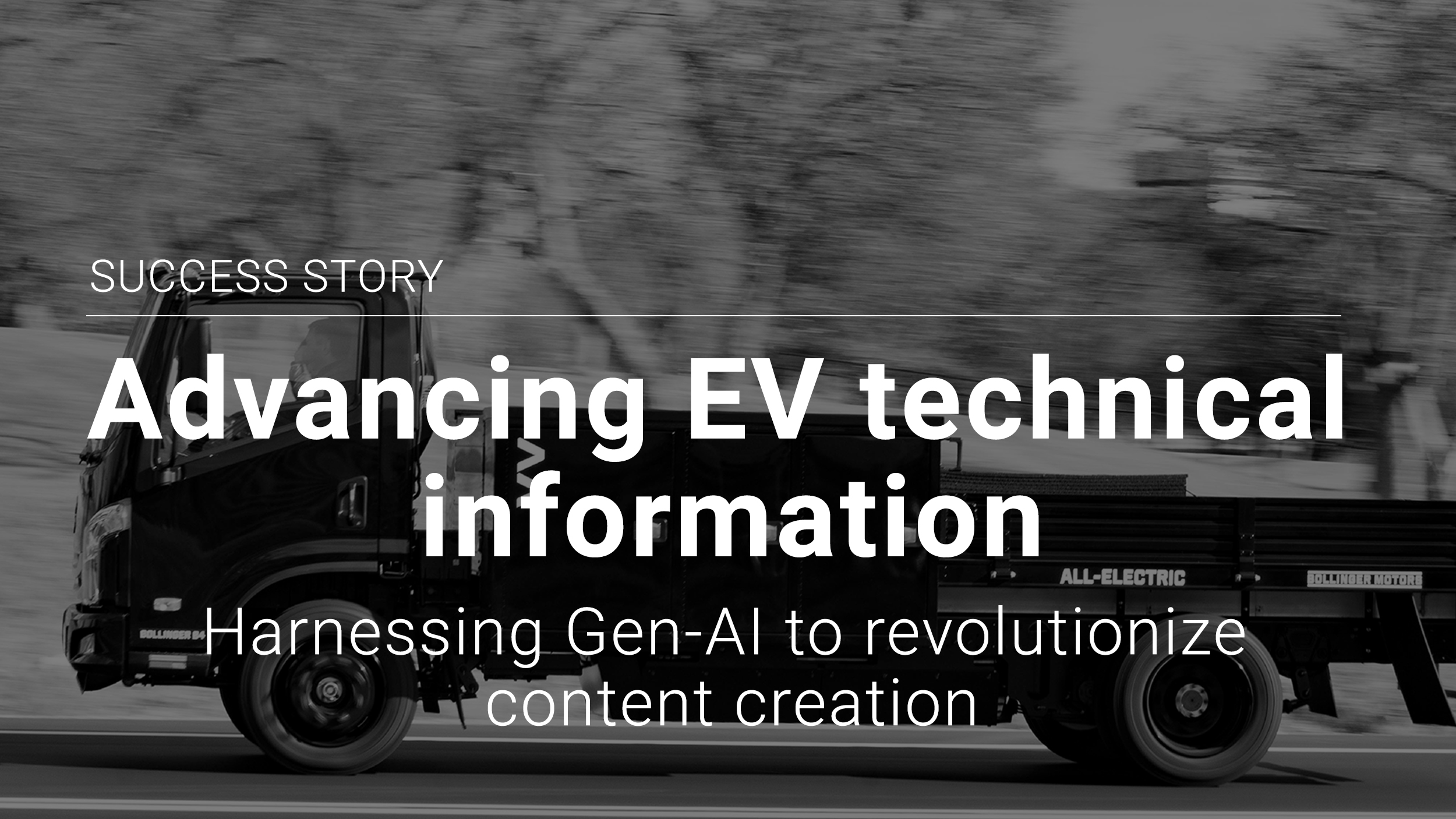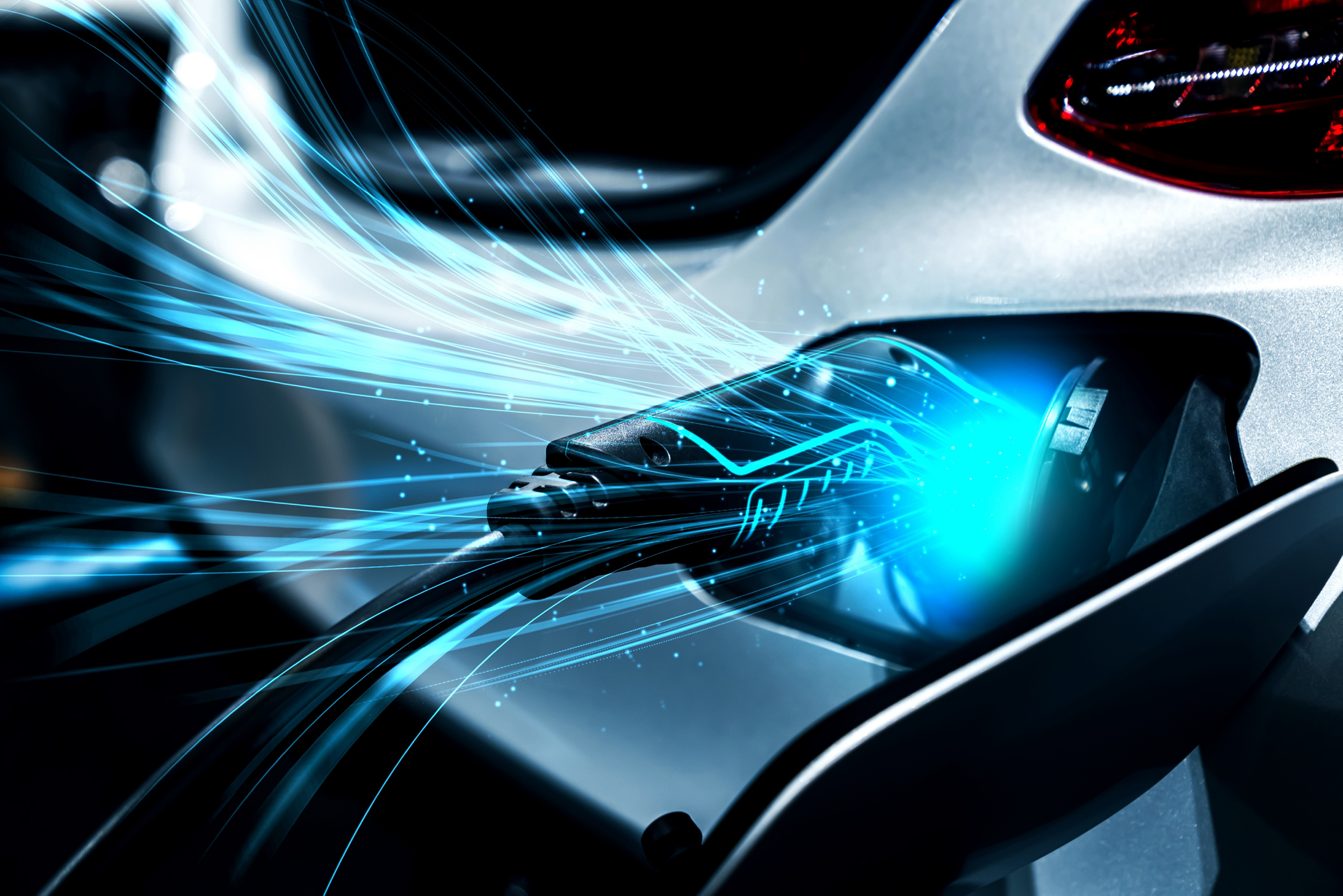
The challenge: Overcoming startup hurdles
Like many startups, Bollinger Motors, a new EV manufacturer focused on medium-duty electric commercial trucks in North America, faces numerous challenges in scaling its operations and ensuring product quality. Their vehicle assembly involves integrating multiple subsystems from various Original Equipment Manufacturers (OEMs) and suppliers. Their biggest challenge, however, is the absence of detailed source information and documentation from many of these third-party suppliers. This posed a significant obstacle in generating the required technical content for service manuals, wiring diagrams, and other essential documents, making traditional content development a slow and costly process.
This lack of comprehensive source documentation would traditionally involve a time-consuming manual process where the team would reverse-engineer similar components, gather field data, validate assumptions, and author documentation from scratch. This slow process put Bollinger at risk of delaying their market entry, with no clear solution in sight.
The challenge: Overcoming startup hurdles
Like many startups, Bollinger Motors, a new EV manufacturer focused on medium-duty electric commercial trucks in North America, faces numerous challenges in scaling its operations and ensuring product quality. Their vehicle assembly involves integrating multiple subsystems from various Original Equipment Manufacturers (OEMs) and suppliers. Their biggest challenge, however, is the absence of detailed source information and documentation from many of these third-party suppliers. This posed a significant obstacle in generating the required technical content for service manuals, wiring diagrams, and other essential documents, making traditional content development a slow and costly process.
This lack of comprehensive source documentation would traditionally involve a time-consuming manual process where the team would reverse-engineer similar components, gather field data, validate assumptions, and author documentation from scratch. This slow process put Bollinger at risk of delaying their market entry, with no clear solution in sight.
The solution: Gen-AI integration with pubFoundry
To overcome these challenges, MSX introduced a game-changing tool, “Pete,” within their content management system (CMS), pubFoundry. Pete is a virtual assistant powered by Generative AI, specifically integrated with OpenAI, that facilitates the creation of technical content in XML, the
format required by the CMS.
Pete functions by scraping the open web for relevant data and assembling a draft of the technical content based on user queries. For instance, if the MSX team needs information about how climate controls work on a specific type of cab, Pete retrieves data and structures it in XML format, tagging the metadata required for pubFoundry integration.
The information can then be integrated seamlessly into pubFoundry, which is crucial for storing, tagging, and publishing technical content. The AI tool within pubFoundry becomes indispensable, allowing the generation, mapping, and manipulation of content into formats that can be readily deployed across multiple platforms, including service manuals, owner manuals, and technician resources. This allows organizations to maintain consistency, accuracy, and scalability in their documentation.
Although the content Pete generates isn’t entirely ready for immediate use, it delivers a solid base that the MSX team can then refine and validate. This eliminates the need for manually gathering source data and reduces the time spent authoring technical information, significantly speeding up the overall process.
This AI-enhanced process is particularly beneficial for EV startups like Bollinger. Without legacy systems and the massive resources of established OEMs, disruptors often face difficulties when scaling rapidly. By utilizing generative AI, startups can overcome the hurdles posed by missing or incomplete documentation, thereby accelerating their product development and entry to market.

The solution: Gen-AI integration with pubFoundry
To overcome these challenges, MSX introduced a game-changing tool, “Pete,” within their content management system (CMS), pubFoundry. Pete is a virtual assistant powered by Generative AI, specifically integrated with OpenAI, that facilitates the creation of technical content in XML, the
format required by the CMS.
Pete functions by scraping the open web for relevant data and assembling a draft of the technical content based on user queries. For instance, if the MSX team needs information about how climate controls work on a specific type of cab, Pete retrieves data and structures it in XML format, tagging the metadata required for pubFoundry integration.
The information can then be integrated seamlessly into pubFoundry, which is crucial for storing, tagging, and publishing technical content. The AI tool within pubFoundry becomes indispensable, allowing the generation, mapping, and manipulation of content into formats that can be readily deployed across multiple platforms, including service manuals, owner manuals, and technician resources. This allows organizations to maintain consistency, accuracy, and scalability in their documentation.

Although the content Pete generates isn’t entirely ready for immediate use, it delivers a solid base that the MSX team can then refine and validate. This eliminates the need for manually gathering source data and reduces the time spent authoring technical information, significantly speeding up the overall process.
This AI-enhanced process is particularly beneficial for EV startups like Bollinger. Without legacy systems and the massive resources of established OEMs, disruptors often face difficulties when scaling rapidly. By utilizing generative AI, startups can overcome the hurdles posed by missing or incomplete documentation, thereby accelerating their product development and entry to market.
The result: Time and cost savings
By using Pete, MSX reduced the time and effort required to create technical content for Bollinger, demonstrating that the integration of Gen-AI has accelerated the technical content creation process. Instead of starting from scratch, the AI-generated content provided a robust foundation that saved considerable manual labor. Additionally, this process minimized the risks of errors and omissions that often occur when working with incomplete or missing documentation.
By leveraging AI, MSX shortened the path to market, ensuring that Bollinger can meet their goal of launching their trucks within a calendar year.

The result: Time and cost savings
By using Pete, MSX reduced the time and effort required to create technical content for Bollinger, demonstrating that the integration of Gen-AI has accelerated the technical content creation process. Instead of starting from scratch, the AI-generated content provided a robust foundation that saved considerable manual labor. Additionally, this process minimized the risks of errors and omissions that often occur when working with incomplete or missing documentation.
By leveraging AI, MSX shortened the path to market, ensuring that Bollinger can meet their goal of launching their trucks within a calendar year.
Gen-AI in technical content creation
As Gen-AI technology continues to evolve, its role in technical content creation is likely to expand. We believe that much like the evolution of translation services—where AI handles 90% of the content, with humans performing a final quality check—technical information authoring will eventually follow suit. Whoever integrates AI most effectively into their content creation workflows will have a significant competitive advantage.
Gen-AI in technical content creation
As Gen-AI technology continues to evolve, its role in technical content creation is likely to expand. We believe that much like the evolution of translation services—where AI handles 90% of the content, with humans performing a final quality check—technical information authoring will eventually follow suit. Whoever integrates AI most effectively into their content creation workflows will have a significant competitive advantage.

“Partnering with MSX allowed us to know we will have the necessary technical information on-time and accurate for our end users, both Customers and Technicians, when launching our EV truck fleet.”
Rob Marcott, Aftersales Network Director, Bollinger Motors

“Partnering with MSX allowed us to know we will have the necessary technical information on-time and accurate for our end users, both Customers and Technicians, when launching our EV truck fleet.”
Rob Marcott, Aftersales Network Director, Bollinger Motors
Fast facts

Customer: Bollinger Motors, a new EV manufacturer focused on medium-duty electric trucks in North America
Business Opportunity: The absence of detailed source information and documentation from many thirdparty suppliers posed a significant obstacle in generating the required technical content for service manuals, wiring diagrams, and other essential documents
Geographical coverage: North America
Solutions implemented: MSX integrated a gen-AI tool within pubFoundry allowing Bollinger Motors to accelerate the development of technical content despite significant gaps in source documentation
Fast facts

Customer: Bollinger Motors, a new EV manufacturer focused on medium-duty electric trucks in North America
Business Opportunity: The absence of detailed source information and documentation from many thirdparty suppliers posed a significant obstacle in generating the required technical content for service manuals, wiring diagrams, and other essential documents
Geographical coverage: North America
Solutions implemented: MSX integrated a gen-AI tool within pubFoundry allowing Bollinger Motors to accelerate the development of technical content despite significant gaps in source documentation

